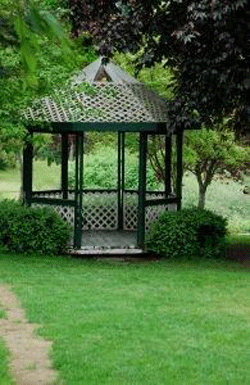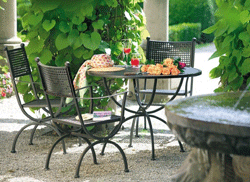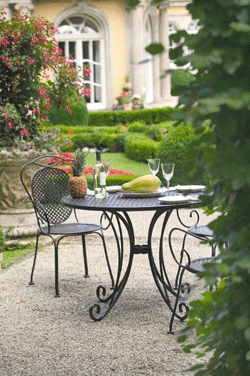Many of us view shade as a challenging location in which to grow plants.
However, there are numerous plants that will thrive in the shadier areas of your garden. If you are fortunate enough to have a garden underneath the canopy of mature shade trees, you will find that there are many advantages that are not found in full sun positioning.
 Advantages
AdvantagesShade gardens are easier to maintain than their sunny counterparts in many ways. First of all, in both summer and winter, the temperatures under the shade canopy remain more constant and less extreme. In summer, the trees protect the plants from the harsh rays of the sun, as well as from heavy rain and hail. While in winter, the tree canopy protects the plants from frost. Because a shade garden is protected from the sun, the need for water is greatly reduced as the soil remains moist for substantially longer. Also, not many weeds thrive in shady areas, cutting the maintenance of a shade garden in half.
Shade
 Before you plant a shade garden, it is important to understand what kind of shade you are planting in. There is a great deal of difference between the solid dense shade created by buildings and dense evergreens, and the dappled shade created by deciduous trees for example. Once you know which kind of shade you are landscaping in, you can chose your plants accordingly. Your local nursery will be able to inform you which plants are best recommended for your particular kind of shade. Basically, one can divide the different kinds of shade into three categories, namely light shade, medium shade and full shade:
Before you plant a shade garden, it is important to understand what kind of shade you are planting in. There is a great deal of difference between the solid dense shade created by buildings and dense evergreens, and the dappled shade created by deciduous trees for example. Once you know which kind of shade you are landscaping in, you can chose your plants accordingly. Your local nursery will be able to inform you which plants are best recommended for your particular kind of shade. Basically, one can divide the different kinds of shade into three categories, namely light shade, medium shade and full shade:- Light shade: Light shade may be described as an area that is shaded, but bright. The shadow of a building or large tree, could provide shade for several hours each day, while the area remains in full sunlight for the rest of the day. In the middle of summer, having the plants protected by shade at noon will provide a beneficial cooling effect, as well as giving flowers and foliage more brilliant colour. Flowering shrubs and flowers do not like the intense midday sun at all, and so thrive by being in the shade for part of the day.

- Medium shade: A medium shade area is present when direct sunlight does not reach the ground for most of the day. This area will, however, get direct sunlight either in the beginning or at the end of the day. The medium shade area can also be classified as those areas of your garden that receives sun that is reflected off a brightly painted wall or a window at certain times of the day.
- Full shade: Full shade lasts all day and no direct sunlight ever reaches the ground at any time of the day. This is the kind of garden area that is usually damp all the time and even in very hot climates, tends to be cool. The dense foliage above it acts like a large blanket, keeping both hot sun and freezing weather at bay.
Do not forget to check the shade situation in your garden throughout the year, because light patterns change with the seasons. Some areas of the garden can be in full shade during summer, while during winter, when the leaves have fallen off certain trees, the area under the tree could be in full or at least dappled sun. Once you have been through a year of studying the shade in your garden, it will be safe to go ahead and plant. At least you won't be in for any surprises.
Planting
 If you are planting beneath large trees creating full shade, make sure you choose plants that thrive in the shade rather than just tolerate the shade. Look up into the tree above your garden and see if there are any branches that can be removed to let in a little more light. Soil that is found under evergreen trees tends to have reduced nutrients in it, because it does not have the benefit of the annual leaf fall that deciduous trees enjoy. As such, composting the soil before planting is a must underneath evergreen trees. In fact, composting is necessary when planting under any trees, as both the tree and the plants growing underneath will be fighting for the same nutrients and compost will help to counteract the shortfall. Composting will ensure that all thrive happily.
If you are planting beneath large trees creating full shade, make sure you choose plants that thrive in the shade rather than just tolerate the shade. Look up into the tree above your garden and see if there are any branches that can be removed to let in a little more light. Soil that is found under evergreen trees tends to have reduced nutrients in it, because it does not have the benefit of the annual leaf fall that deciduous trees enjoy. As such, composting the soil before planting is a must underneath evergreen trees. In fact, composting is necessary when planting under any trees, as both the tree and the plants growing underneath will be fighting for the same nutrients and compost will help to counteract the shortfall. Composting will ensure that all thrive happily. When choosing what plants to put in your full shade garden, concentrate on plants with light coloured flowers or foliage. This will make a bigger impact as they will be easier to see than their dull counterparts. No fruits and vegetables will grow in full shade, however, many vegetables will grow in light shade, but they will produce a lot less crop than if they were growing in the full sun.
When choosing what plants to put in your full shade garden, concentrate on plants with light coloured flowers or foliage. This will make a bigger impact as they will be easier to see than their dull counterparts. No fruits and vegetables will grow in full shade, however, many vegetables will grow in light shade, but they will produce a lot less crop than if they were growing in the full sun.The well-maintained shade garden is a blessing in the
 hot summer months and can be used as a wonderful area in which to relax and recuperate from the harsh midday sun. With the lovely cool air, sweet fragrances and maybe a water feature, the shaded garden can become a firm favourite summer outdoor retreat. – Antonella Dési
hot summer months and can be used as a wonderful area in which to relax and recuperate from the harsh midday sun. With the lovely cool air, sweet fragrances and maybe a water feature, the shaded garden can become a firm favourite summer outdoor retreat. – Antonella DésiPictures
Images courtesy of:
- MBM
For more information Click here to visit the MBM website.
Property News
Click here for more property news articles.
Need a blog?
Start your own blog with a free blog from 24.com.








